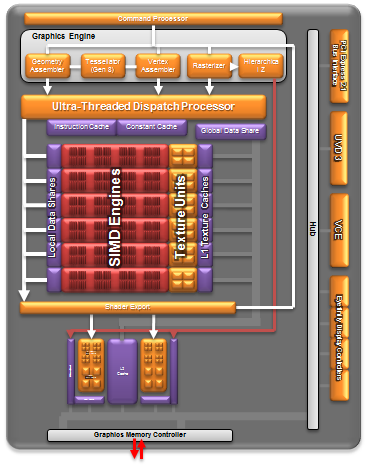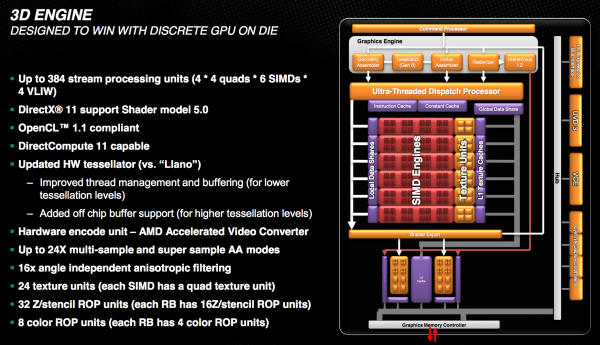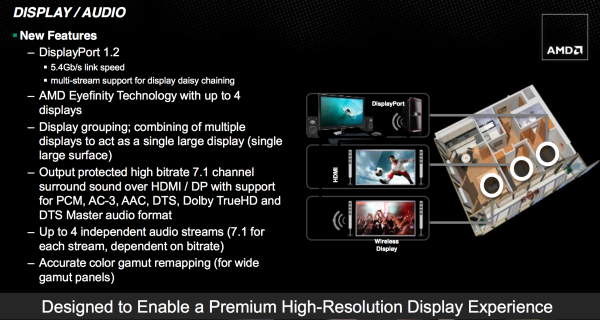The AMD Trinity Review (A10-4600M): A New Hope
by Jarred Walton on May 15, 2012 12:00 AM ESTImproved Turbo
Trinity features a much improved version of AMD's Turbo Core technology compared to Llano. First and foremost, both CPU and GPU turbo are now supported. In Llano only the CPU cores could turbo up if there was additional TDP headroom available, while the GPU cores ran no higher than their max specified frequency. In Trinity, if the CPU cores aren't using all of their allocated TDP but the GPU is under heavy load, it can exceed its typical max frequency to capitalize on the available TDP. The same obviously works in reverse.
Under the hood, the microcontroller that monitors all power consumption within the APU is much more capable. In Llano, the Turbo Core microcontroller looked at activity on the CPU/GPU and performed a static allocation of power based on this data. In Trinity, AMD implemented a physics based thermal calculation model using fast transforms. The model takes power and translates it into a dynamic temperature calculation. Power is still estimated based on workload, which AMD claims has less than a 1% error rate, but the new model gets accurate temperatures from those estimations. The thermal model delivers accuracy at or below 2C, in real time. Having more accurate thermal data allows the turbo microcontroller to respond quicker, which should allow for frequencies to scale up and down more effectively.
At the end of the day this should improve performance, although it's difficult to compare directly to Llano since so much has changed between the two APUs. Just as with Llano, AMD specifies nominal and max turbo frequencies for the Trinity CPU/GPU.
A Beefy Set of Interconnects
The holy grail for AMD (and Intel for that matter) is a single piece of silicon with CPU and GPU style cores that coexist harmoniously, each doing what they do best. We're not quite there yet, but in pursuit of that goal it's important to have tons of bandwidth available on chip.
Trinity still features two 64-bit DDR3 memory controllers with support for up to DDR3-1866 speeds. The controllers add support for 1.25V memory. Notebook bound Trinities (Socket FS1r2 and Socket FP2) support up to 32GB of memory, while the desktop variants (Socket FM2) can handle up to 64GB.
Hyper Transport is gone as an external interconnect, leaving only PCIe for off-chip IO. The Fusion Control Link is a 128-bit (each direction) interface giving off-chip IO devices access to system memory. Trinity also features a 256-bit (in each direction, per memory channel) Radeon Memory Bus (RMB) direct access to the DRAM controllers. The excessive width of this bus likely implies that it's also used for CPU/GPU communication as well.
IOMMU v2 is also supported by Trinity, giving supported discrete GPUs (e.g. Tahiti) access to the CPU's virtual memory. In Llano, you used to take data from disk, copy it to memory, then copy it from the CPU's address space to pinned memory that's accessible by the GPU, then the GPU gets it and brings it into its frame buffer. By having access to the CPU's virtual address space now the data goes from disk, to memory, then directly to the GPU's memory—you skip that intermediate mem to mem copy. Eventually we'll get to the point where there's truly one unified address space, but steps like these are what will get us there.
The Trinity GPU
Trinity's GPU is probably the most well understood part of the chip, seeing as how its basically a cut down Cayman from AMD's Northern Islands family. The VLIW4 design features 6 SIMD engines, each with 16 VLIW4 arrays, for a total of up to 384 cores. The A10 SKUs get 384 cores while the lower end A8 and A6 parts get 256 and 192, respectively. FP64 is supported but at 1/16 the FP32 rate.

As AMD never released any low-end Northern Islands VLIW4 parts, Trinity's GPU is a bit unique. It technically has fewer cores than Llano's GPU, but as we saw with AMD's transition from VLIW5 to VLIW4, the loss didn't really impact performance but rather drove up efficiency. Remember that most of the time that 5th unit in AMD's VLIW5 architectures went unused.
The design features 24 texture units and 8 ROPs, in line with what you'd expect from what's effectively 1/4 of a Cayman/Radeon HD 6970. Clock speeds are obviously lower than a full blown Cayman, but not by a ton. Trinity's GPU runs at a normal maximum of 497MHz and can turbo up as high as 686MHz.
Trinity includes AMD's HD Media Accelerator, which includes accelerated video decode (UVD3) and encode components (VCE). Trinity borrows Graphics Core Next's Video Codec Engine (VCE) and is actually functional in the hardware/software we have here today. Don't get too excited though; the VCE enabled software we have today won't take advantage of the identical hardware in discrete GCN GPUs. AMD tells us this is purely a matter of having the resources to prioritize Trinity first, and that discrete GPU VCE support is coming.















271 Comments
View All Comments
meloz - Tuesday, May 15, 2012 - link
Quiet underwhleming. :\On the CPU side, IVB absolutely clobbers Trinity. People keep saying [FONT="Arial Narrow"]"CPU don't matter"[/FONT], but if you have a SSD the 'bottleneck' immediately shifts back to the CPU for certain tasks. It is always nice to have good single thread performance, and Intel enjoys a huge advantage in this area.
On the iGPU side, the much derided and seemingly impotent HD 4000 manages to actually narrow the lead AMD enjoyed on the graphics side. If only Intel drivers were written by people who had any clue, they would get even better performance out of their silicon.
So it will all come down to pricing. This is as much in Intel's hand as AMD's. AMD can potentially sell a lot of these things, but at a price where they won't be making any profits.
Congratulations to JW on another fine review, but a very underwhelming new product from AMD, as I said earlier.
jabber - Tuesday, May 15, 2012 - link
Trust me, no one applauds if I hold up my laptop and shout "BEHOLD THE WONDEROUS SINGLETHREADED PERFORMANCE! BASK IN IT'S POWER!!!"You are making too much of too little really.
meloz - Tuesday, May 15, 2012 - link
"You are making too much of too little really. "The marketshare and sales performance of the two rival products immediately proves you wrong. But keep digging the hole. Need a Bulldozer (or is it time for an Excavator) to speed up the processs?
jabber - Tuesday, May 15, 2012 - link
You're right, I'm obviously just not taking the issue as seriously as you are.Enjoy the endless benchmarking!
Ahem....
Taft12 - Tuesday, May 15, 2012 - link
AMD can't produce enough chips to meet demand and is improving marketshare every quarter. Their <1% quarterly increases are more like digging with a spoon, but it's digging in the right direction.medi01 - Thursday, May 17, 2012 - link
Market share means nothing, silly. Prescott had much bigger share than Athlon 64, while being inferior on all fronts.Spunjji - Wednesday, May 16, 2012 - link
Who's deriding the HD 4000? :/medi01 - Thursday, May 17, 2012 - link
If you have SSD bottleneck is your brain, that is too slow to distinguish between 22ms and 24ms.There is no way 20% faster version of an ALREADY SUCCESSFULL product is "underwhelming".
cjs150 - Tuesday, May 15, 2012 - link
Am aiming to start an HTPC build in the next couple of months. Mostly for movies but a little light gaming from time to time (Total War: Shogan on a 47" HD screen!)Low power of Trinity looked very promising...then I read Jarred's review.
Back to the i7-3770T even though the CPU+motherboard will be at least twice the price of the AMD versions.
Assimilator87 - Tuesday, May 15, 2012 - link
The desktop version of Trinity should fare better because of the TDP headroom, although it's extremely disappointing that it won't be released 'till Q3. I guess my mini-ITX case will have to sit in its box for another few months.